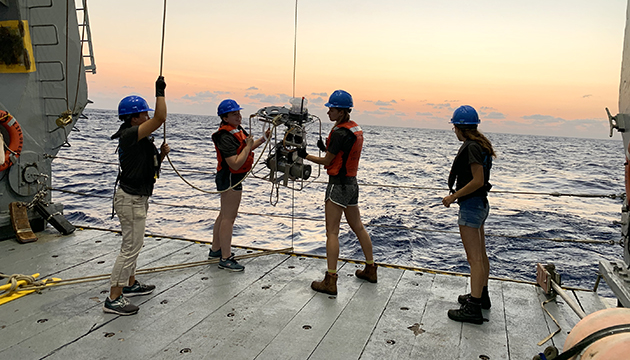Posted in:
The Sargasso Sea has become warmer and saltier, and the loss of oxygen and ocean acidification is accelerating

Ella Cedarhold (Marine Technician), Claire Medley (Research Technician), Emily Davey (Research Technician), and Lydia Sgouros (Marine Technician) deploy an in-situ pump off the stern of the R/V Atlantic Explorer for proteomics sampling during a recent Bermuda Atlantic Time-series Study (BATS) cruise.
These are the findings from nearly forty years of shipboard observations made in the deep Sargasso Sea offshore of the verdant island and surrounding coral reefs of Bermuda.
Fortuitously situated in the middle of the North Atlantic Ocean subtropical gyre, in the Sargasso Sea, scientific discoveries in this region began more than one hundred and twenty years ago with the founding of the Bermuda Biological Station for Research, now known as the Bermuda Institute of Ocean Sciences (BIOS).
After the end of Second World War, Hank Stommel, a pioneering oceanographer from Woods Hole Oceanographic Institution in Cape Cod, thought Bermuda would make an excellent place from which to mount sustained observations of the deep sea at a site called Hydrostation ‘S’, located approximately 25 km southeast of the island. His quote “If Bermuda did not exist, oceanographers would have invented it!” remains just as relevant today as when he first wrote it. Out in the seemingly infinite sea, far from the sight of land and in the realm of flying fishes, clumps of floating Sargassum weed, and home to pelagic seabirds such as the petrel Cahow––thought extinct for most of the nineteenth century––these observations continue to the present day.
In the late 1980s, hypothesis-testing and discovery-making expanded with the establishment of the Bermuda Atlantic Time-series Study (BATS) and its studies of the physics, chemistry and biology of the ocean. After my own brief introduction in the 1980s to a disorientating and small ship (which has been replaced by the 170’ Research Vessel Atlantic Explorer), I have not been able to enjoy sea time. But, the BATS and Hydrostation S programs continue due to a team of dedicated scientists and ship’s crew, the support of the entire institution, and the US National Science Foundation. In winter, the seas are grey and rough, with rolling waves and white caps, and calmer in the summer, the waters deep blue in colour, with an occasional retreat to the safe harbour with the passage of hurricanes.
In 2020, with strict protocols in place due to the COVID-19 pandemic and adjustments in our approach to ship and laboratory work, we continue to conduct scientific cruises and collect data at the BATS and Hydrostation ‘S’ sites. Over the last forty years, which constitutes the longest set of prolonged observations in the open ocean anywhere on the planet, the surface ocean has warmed by nearly 1°C, with significant warming over the last decade. Surface waters have become measurably saltier, and the rate of loss of dissolved oxygen is higher than other areas. The Sargasso Sea has also absorbed human-produced carbon dioxide (CO2) from the atmosphere with anthropogenic CO2 almost doubling since the 1980s. Ocean acidity has increased substantially such that the seasonal chemical conditions observed in 2020 are now outside the range seen only a few decades before. The winter ocean season is shorter, and the summer is more extended, and we anticipate that the biology and marine ecosystem will also change in concert with these changes.
Ocean observations, such as those made at BATS and Hydrostation ‘S’, constitute only a handful of marine sites that have been maintained over more than a few decades. As such, they represent sentinels of ocean change for oceanographers and those interested in the ocean environment. In the open ocean, the sea offers hardly visible signs of change, but data collected over the past forty years illustrates profound changes in the oceans chemical and biological condition. And with future hypothesis-testing and discovery, our collaborative community of scientists endeavour to uncover critically required knowledge about the causes and future of environmental change.
Tagged:


